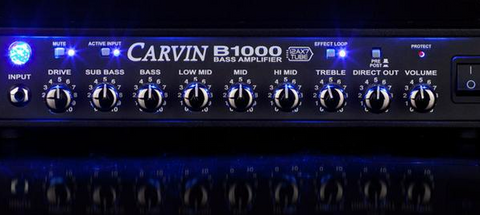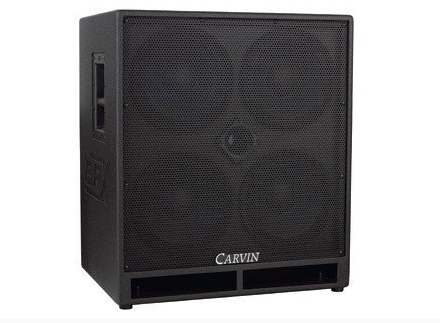-
Audio
-
Guitar
- Bass
-
Blog
-
SALE
- Financing
- Support
- SINCE 1946
January 10, 2017

If your primary axe is a five-string bass, you may need to take some extra care and considerations in choosing the bass rig that will help you sound your best. While most bass gear will work fine- all of Carvin Audio’s bass amp heads and cabinets, for instance, accommodate four and five string players alike- it's important to take some time to dig into the specs and features of the next rig you have in mind. While your ears will be the ultimate judge, this article will cover three simple things you could look at in your prospective rig or even your current one: the frequency response of your cabinets, the equalization options of your bass head, and the total wattage of your rig.
Check Out the Frequency Response Numbers
One of the main specs that bassists look at to get a better idea of a speaker cabinet’s real life performance is the frequency response. As a point of reference, the low E string on a four string bass guitar vibrates at 41Hz. When you’re rocking a five-string, the low B comes in at about 31 Hz, so ideally you will want a cabinet that can really push out those low notes with authority and power to spare. This is not to say a cabinet whose specs don’t show it being able to go down to 31 Hz will not work for you at all, but frequency response does provide an indication of the cabinet’s overall output capability. A large component of these frequency response numbers depends on whether the cabinet is sealed or ported and the overall size and design, so it’s a good place to start. Another key component of the frequency response is the SPL output of the cabinet. This can be specified as sensitivity at 1 watt at 1 meter, 1w/1m, and/or it can be in maximum SPL, MAX SPL, where the peak power handling is calculated in DB and added to the 1w/1m specification. Either way the higher this number is the more output, but do compare similar specs of sensitivity at 1w/1m or MAX SPL together and not to each other.
MAX SPL = 1w/1m (sensitivity) + 10 * log (peak wattage handling)
 The ported Carvin Audio BRX10.4 is ideal for five string players and faithfully reproduces the low B, spanning frequencies from 28 Hz to 22 kHz. All the pant-leg-flapping low end you need without using a subwoofer!
The ported Carvin Audio BRX10.4 is ideal for five string players and faithfully reproduces the low B, spanning frequencies from 28 Hz to 22 kHz. All the pant-leg-flapping low end you need without using a subwoofer!
Make Sure Your Amp EQ Works with Your Bass
Upon first glance, every bass amp’s standard bass, mid, and treble seem similar. While they do serve the same function, it really helps to dig a little deeper and determine the frequency points that those EQ controls are centered at. Not all amps will have these listed on the front panel, so you may have to refer to the manual or spec sheet. Doing this is important, as bass amplifier heads with limited EQ capabilities may not allow you to really dial in the deep lows of your sound, and these frequencies can really help a five-string come to life! (Certain bass heads, for instance, center their bass control around 50 or 60 Hz). It’s not necessary to have an amp that has 31 Hz listed as a center frequency. But it’s highly beneficial to choose one that allows you an adequate degree of fine tuning in the low range. Even after you’ve checked the specs, spend as much time as you can playing through the amp with your cabinet of choice to see if the lower notes have the right voicing for you.
The Sub Bass control on the Carvin Audio B1000 adds some chest-thumping low end that is more felt than heard, which is perfect for five-strings. Further tweak the low end tone using the bass knob.
Having Clean Headroom is a Good Thing
Lastly, remember that low frequencies take more power to amplify, which is part of the reason why bassists need more wattage and more speakers than their guitar-playing counterparts. If you’re going to be grooving on that low B all night, a head with wattage to spare and a cabinet that can handle all the power that the head can throw at it are essential, especially with minimal or no PA support. If you’re a five-string player, choose an amplifier that’s more than powerful enough for your gigs and rehearsals and can get you that big, powerful low B without you having to push your amp (or cab!) too hard. Remember, you can always turn it down!
March 28, 2025
At any time at any gig, something is bound to go wrong and you may need a tool to get you back up and running. Here are a few basic tools you should bring to every gig.
January 09, 2025
I once asked blues legend Walter Trout why he still plays his well-worn vintage Strat. The technology exists to digitally scan the guitar and make very accurate replicas. His response was he could leave it at home, but then it will never be played. Plus, someone could steal it from his home. At least the guitar is with him and he has the pleasure of playing it. But this may not be the same for everyone.
December 09, 2024
With modern day effects, it is possible to easily replicate guitar tones from early rock and roll in the 1950s to modern hard rock or metal.
Sign up to get the latest on sales, new releases and more…
NoFraud Frequently Asked Questions
"Make a joyful noise unto the Lord all of the earth; make a loud noise and rejoice and sing praises. Sing to the Lord with the harp and the voice of the psalm." - Psalm 98:4-5
© 2025 Carvin Audio.
Carvin Corp.
POS and Ecommerce by Shopify
